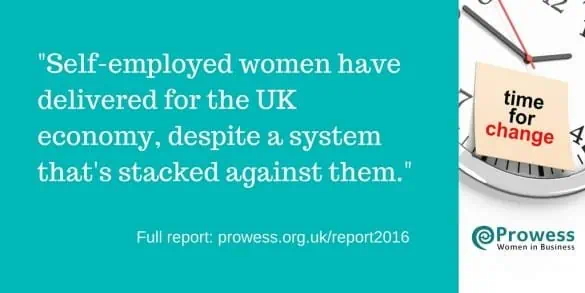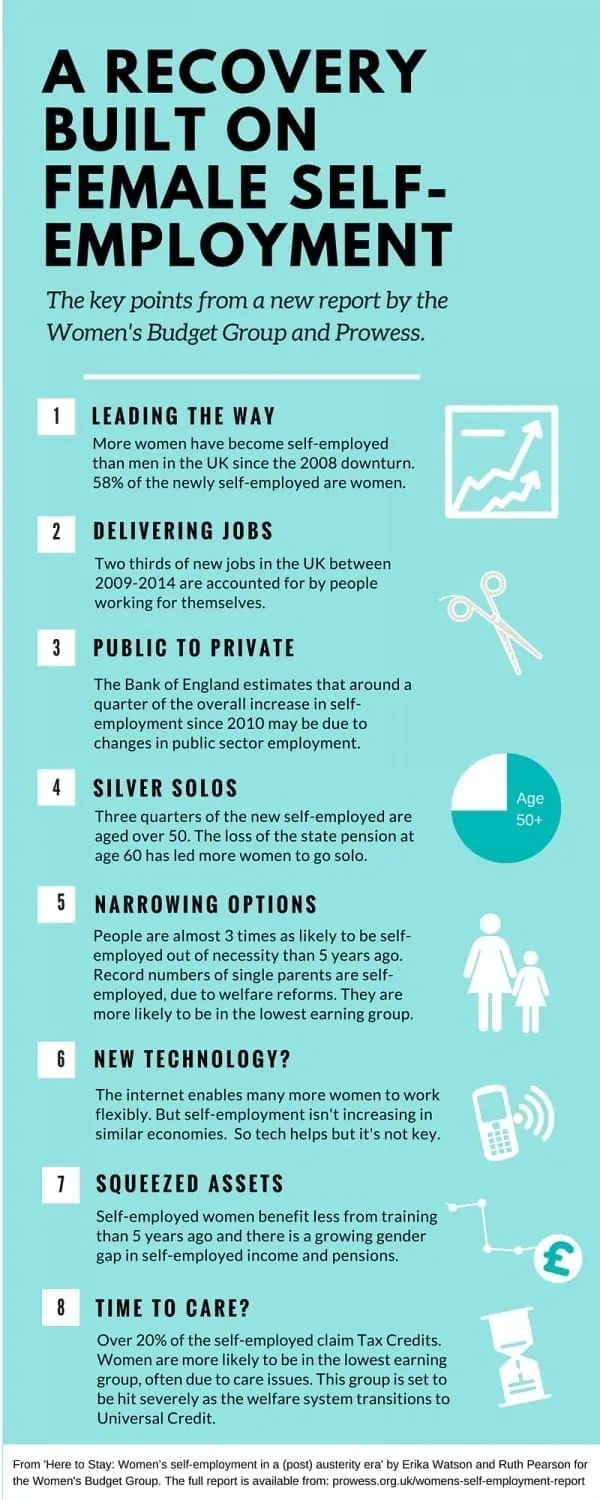Self-employed women have delivered most of the new jobs underpinning the UK’s tentative economic recovery, despite a system that is increasingly stacked against them. Rather than reaping the fiscal rewards, self-employed women are instead facing growing gender gaps in investment, training, pensions and income. Those trends have been captured in a new policy report from the Women’s Budget Group and Prowess, written by Erika Watson and Professor Ruth Pearson.
 The context for the report, ‘Here to Stay: Women’s self-employment in a (post) austerity era’ is an unprecedented rise in UK self-employment. Self-employment in the UK is at the highest point since records began 40 years ago, with the number of self-employed increasing by 650,000 since 2008 to reach 4.5 million. Self-employed women are the majority of the newly self-employed. Historically, women have made up just over a quarter of the self-employed, but since the 2008 downturn 58% of the newly self-employed have been female.
The context for the report, ‘Here to Stay: Women’s self-employment in a (post) austerity era’ is an unprecedented rise in UK self-employment. Self-employment in the UK is at the highest point since records began 40 years ago, with the number of self-employed increasing by 650,000 since 2008 to reach 4.5 million. Self-employed women are the majority of the newly self-employed. Historically, women have made up just over a quarter of the self-employed, but since the 2008 downturn 58% of the newly self-employed have been female.
Key trends and challenges covered in the Briefing include:
- While for many women self-employment is a positive option allowing them to pursue fulfilling and flexible work, for a growing proportion self-employment does not appear to be a “choice” but a necessity driven by factors such as public sector job losses, the uprating of the female retirement age, or a need to accommodate caring responsibilities.
- The self-employed are working longer hours and earning less. Despite the rise in the number of self-employed, between 2009 to 2013 their income as a group declined by around £8 billion (from £88.4 to £80.6 billion).
- The gender pay gap for the self-employed stands at 41% and, as such, self-employment may be a route into low pay for some women
- Productivity of the self-employed has declined by 32% since 2008
- Low earnings and productivity have implications for the economy as a whole, with the State foregoing considerable tax revenue as a result of declining earnings.
- Gender-blind policy setting has led to an enterprise support infrastructure and incentives that are primarily taken up by men.
The Briefing Paper proposes a comprehensive set of measures to tackle these challenges, including:
- A woman-friendly enterprise support infrastructure
- Equalised parental benefits for the self-employed.
- Strengthened provisions for flexible working to provide more opportunities for those women who would like to remain employees and combine this with caring responsibilities
- Review of Universal Credit to eliminate barriers to self-employment, including the capital limit which is likely to undermine the asset base of some newly self-employed
- Gender disaggregated information on uptake of business support measures to enable effectiveness to be assessed
- Inclusion of the self-employed in official earnings data through an ‘All worker’ category
You can read and download the full report here.. And you can share and review a summary of the key points in the infographic below.



Really interesting stuff here, especially how many more people are taking up self-employment because of necessity – it’s usually seen as more of a luxury option. The full report is definitely worth a read – particularly hoping that more can be done regarding woman-friendly support infrastructure.